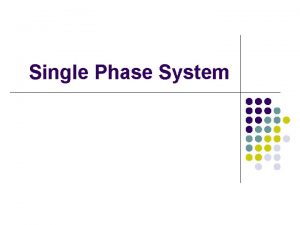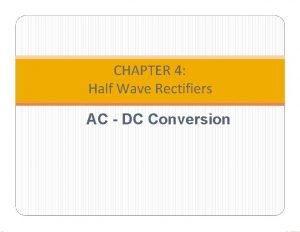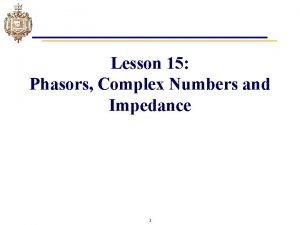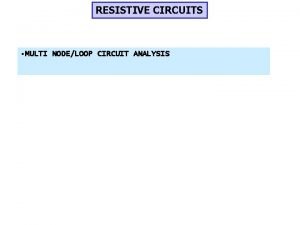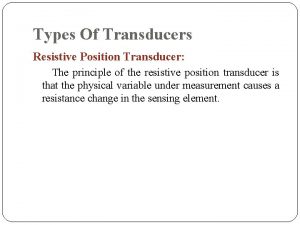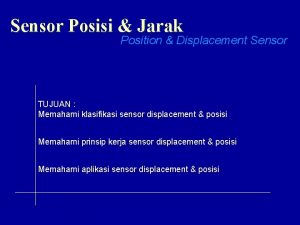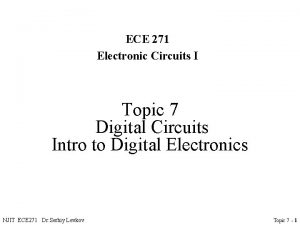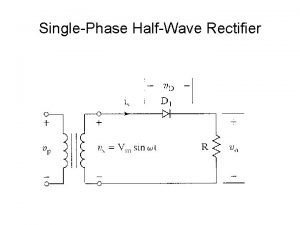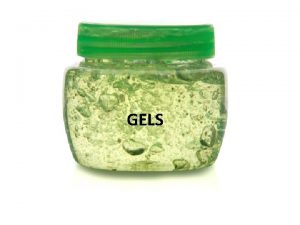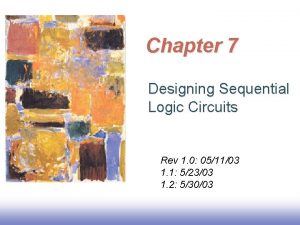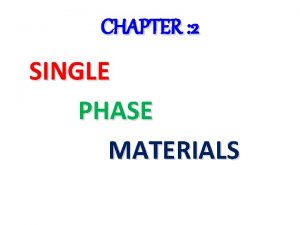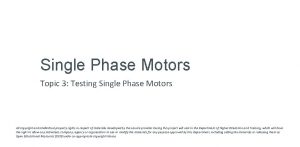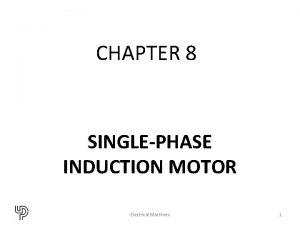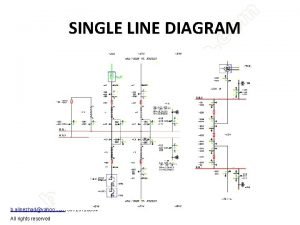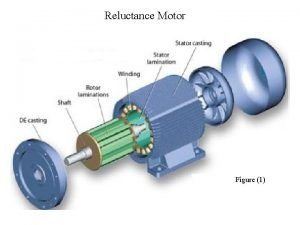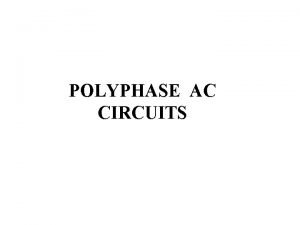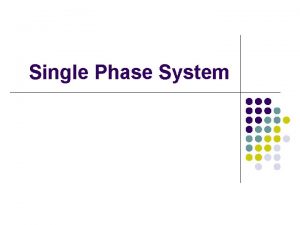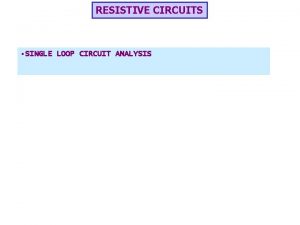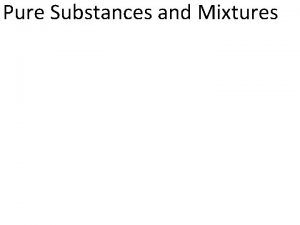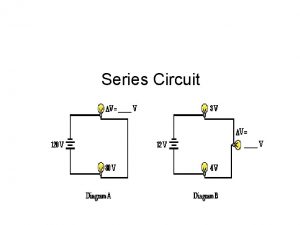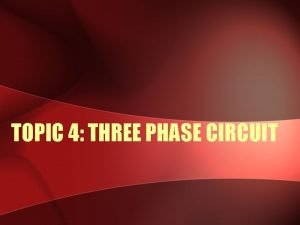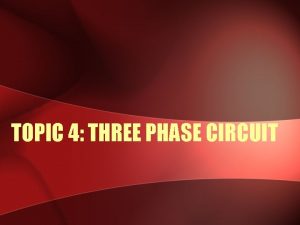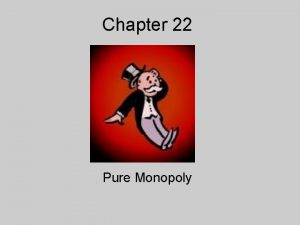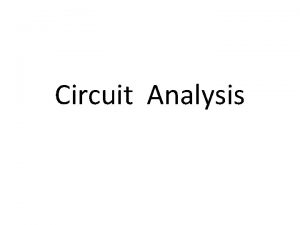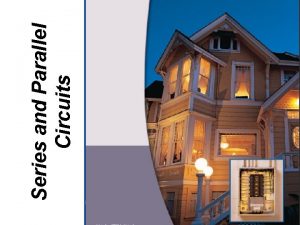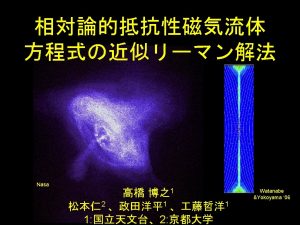Single Phase System Pure Resistive Circuit in Series








































- Slides: 40

Single Phase System

Pure Resistive Circuit in Series i Instantaneous voltage is given by v = Vm sin t Instantaneous current is given by v The maximum value for current Im and maximum value for voltage Vm can be related as Im = Vm/R The rms value for current Irms (simply I) and rms value for voltage Vrms (simply V) can be related as I = V/R R

In circuit contains resistor , the V and I are in phase as in diagram below waveform + Vm Im current voltage - V phasor I time

Power dissipated in the resistor p = i 2 R = (Im 2/R)sin 2 t p = v 2/R = (Vm 2/R) sin 2 t p = vi = Vm. Im sin 2 t Average value for power

power p current i voltage v Wave in pure resistance circuit

Pure Inductive Circuit in Series If the current isi = Im sin t; i v Thus Vm= L Im The voltage is leading the current by /2 rad (90 o) OR current is lagging behind the voltage by /2

v, i Vm v i Im tt /2 Voltage and current waveform in a purely inductive circuit Maximum voltage: Vm = LIm Voltage r. m. s value. : V = LI where = 2 f V/I = Vm/Im = L = XL XL is measured in ohm and called as inductive reactance= L

Changes of I and XL with frequency I, XL X I L f Phasor for purely inductive circuit V 90 90 E I

Power dissipated in purely inductive circuit P = vi = (Im sin t)(Vm sin ( t + /2) = Vm. Im sin t [sin t cos /2 + cos t sin /2 ] = Vm. Im sin t cos t = ½Vm. Im sin 2 t Average power Half cycle has cancelled the other half cycle that is why the average power is zero.

v, i, p p v i + + - - CURRENT, VOLTAGE AND AVERAGE POWER WAVEFORM IN A PURELY INDUCTIVE CIRCUIT. t

Pure capacitive Circuit in Series If the voltage is given as Then v = Vm sin t i v Therefore Im= C Vm In this case the current is leading a voltage by /2 ( 90 o) OR voltage is lagging behind the current by /2.

v, i Vm Im v i t /2 AC VOLTAGE AND CURRENT WAVEFORM IN PURELY CAPACITIVE CIRCUIT Maximum current value Im = CVm r. m. s value. : I = CV ratio V/I = Vm/Im = 1/ C = XC XC = is measured in ohm and called as capacitive reactance =1/ C

Changes of I and XC with frequency I, Xc Xc I f Phasor diagram I /2 V

Power dissipated by capacitor p = vi = (Vm sin t)(Im sin ( t + /2)) = Vm. Im sin t sin ( t + /2) = Vm. Im sin t [sin t cos /2 + cos t sin /2 ] = Vm. Im sin t cos t = ½Vm. Im sin 2 t Average power Half cycle has cancelled the other half cycle that is why the average power is zero.

voltan v arus i Kuasa p CURRENT, VOLTAGE AND POWER IN PURELY CAPACITIVE CIRCUIT

i If i = Im sin t Then v. R v v. L v. R = i. R = Im. R sin t in phase with i v. L = i. XL = Im. XLsin ( t + /2) = LIm sin ( t + /2) leading the i by /2 v = v. R + v. L = Im. R sin t + LIm sin ( t + /2) = Im. R sin t + LIm cos t v = Vm sin ( t + ) (1) Where (2) and = tan-1( L/R) (3)

Current and Voltage waveform in L-R serial circuit v, i v. R t v. L VR in phase with I VL is leading in phase with I by /2

Phasor diagram for I, VR, VL & V in R & L serial circuit VL V /2 I VR • I and VR overlap to represent the in phase • VL is vertical to represent the 90 o leading out of phase • Resultant between VL and VR give the value of V and The representation of voltage can be written as V /

XL Phasor diagram for I, R, XL & Z in R & L serial circuit Z /2 I Impedance is represented as R

p = vi = Vm sin ( t + ) Im sin t = ½Vm. Im [cos - cos (2 t - )] = ½Vm. Im cos - ½Vm. Im cos (2 t - ) component ½Vm. Im cos (2 t - ) is zero Therefore the average value is only given by

CURRENT, VOLTAGE AND POWER WAVEFORMS FOR L-R SERIAL CIRCUIT V, I P p i t v i v R, XL, Z ( ) Z X L R f (Hz)

Phasor diagram V I cos I VR = V cos I sin We can also calculate the power from P = I 2 R or P = VR 2/R or VRI All in r. m. s values I= Irms , VR=VRrms From phasor diagram P=VRI=VIcos (active power) Cos is a power factor cos = VR/V = R/Z. Reactive power (VAR) = VLI = VI sin

A resistance of 7. 0 is connected in series with a pure inductance of 31. 8 m. H and the circuit is connected to a 100 V, 50 Hz, sinusoidal supply. Calculate (a) the circuit current. (b) the phase angle

A pure inductance of 318 m. H is connected in series with a pure resistance of 75. The circuit is supplied from a 50 Hz sinusoidal source and the voltage across the 75 resistor is found to be 150 V. Calculate the supply voltage check

A coil, having both resistance and inductance, has a total effective impedance of 50 and the phase angle of the current through it with respect to the voltage across it is 45 o lag. The coil is connected in series with a 40 resistor across a sinusoidal supply. The circuit current is 3 A; by constructing a phasor diagram, estimate the supply voltage and the circuit phase angle

VLr cosf. Lr

A coil having a resistance of 12 W and a inductance of 0. 1 H is connected across a 100 V, 50 Hz supply. Calculate: (a)The reactance and the impedance of the coil; (b)The current; (c)The phase difference between the current (d) and the applied voltage:

i If i = Imsin t v. R = i. R = Im. R sin t --- in phase with i v. C v = v. R + v. C Vc is lagging by 90 o refer to I = (Im/ C) sin ( t - /2) + Im. R sin t v = Vm sin ( t - ) where ; ; and

v. R /2 / 3 /2 2 / v v. C i CURRENT AND VOLTAGE WAVEFORMS IN R-C SERIAL CIRCUIT t

Phasor diagram Impedance triangle I I VR - - /2 R /2 V VC Z XC = tan-1 (VC/VR) = tan-1 (XC/R) Z - Can be written as where = 2 f

POWER p = vi = Vm sin ( t - ) Im sin t = ½Vm. Im [cos - cos (2 t - )] = ½Vm. Im cos - ½Vm. Im cos (2 t - )] The average of component [½Vm. Im cos (2 t - )] is zero, therefore p CURRENT, VOLTAGE AND POWER WAVEFORMS FOR R-L SERIAL CIRCUIT t i v

Phasor diagram I sin We can also calculate the power from P = I 2 R or P = VR 2/R or VRI All in r. m. s values I= Irms , VR=VRrms I I cos From phasor diagram P=VRI=VIcos (active power) V Cos is a power factor Cos = VR/V = R/Z. Z Reactive power (VAR) = VCI = VI sin R XC f

A capacitor of 8. 0 m. F takes a current of 1. 0 a when the alternating voltage applied across it is 230 V. Calculate: (a)The frequency of the applied voltage; (b)The resistance to be connected in series with the capacitor to reduce the current in the circuit to 0. 5 A at the same frequency; (c)The phase angle of the resultants circuit. (a)

(b) (c) Leading by 30 o

A metal-filament lamp, rated at 750 W, 100 V, is to be connected in series with a capacitor across a 230 V, 60 Hz supply. Calculate: (a)The capacitance required (b)The phase angle between the current and the supply voltage


From phasor diagram, since the voltage VL (BO) and VC (CO) are in line, thus the resultants for these two component is DO (BO-CO) which is not involved in phase. AO is the voltage across R. Thus EO 2= AO 2 + DO 2

Therefore the impedance is

A circuit having a resistance of 12 , an inductance of 0. 15 H and a capacitance of 100 m. F in series, is connected across a 100 V, 50 Hz supply. Calculate: (a)The impedance; (b)The current; (c)The voltage across R, L and C; (d)The phase difference between the current and the supply voltage (a) note XL=47. 1 XC=31. 85

 Pure resistive circuit
Pure resistive circuit Vdc formula for half wave rectifier
Vdc formula for half wave rectifier Eli the ice man
Eli the ice man Resistive circuit analysis
Resistive circuit analysis Single channel single phase example
Single channel single phase example Circuit in parallel vs series
Circuit in parallel vs series Two types of circuits
Two types of circuits In series vs in parallel
In series vs in parallel Klews chart
Klews chart Advantages of parallel circuit over series circuit
Advantages of parallel circuit over series circuit Resistive transducer application
Resistive transducer application Resistive soil moisture sensor working principle
Resistive soil moisture sensor working principle Resistive displacement sensor
Resistive displacement sensor Isokinetic exercise definition
Isokinetic exercise definition Static power dissipation in nmos inverter
Static power dissipation in nmos inverter Resistive switching
Resistive switching Renal index
Renal index Nmos inverter with resistive load
Nmos inverter with resistive load Normal phase vs reverse phase chromatography
Normal phase vs reverse phase chromatography Tswett pronunciation
Tswett pronunciation Mobile phase and stationary phase
Mobile phase and stationary phase What is mobile and stationary phase
What is mobile and stationary phase Normal phase vs reverse phase chromatography
Normal phase vs reverse phase chromatography Line vs phase voltage
Line vs phase voltage Adsorption chromatography
Adsorption chromatography In a triangle connected source feeding a y connected load
In a triangle connected source feeding a y connected load Csce 441
Csce 441 Transformer utilization factor
Transformer utilization factor Semi converter operates in which quadrant
Semi converter operates in which quadrant Gels are
Gels are Single phase dual converter
Single phase dual converter Tspc d flip flop
Tspc d flip flop Single phase alloy
Single phase alloy Types of ac voltage controller
Types of ac voltage controller Test single phase motor
Test single phase motor Single phase induction motor
Single phase induction motor Busbar single line diagram
Busbar single line diagram Motor figure
Motor figure Eee g
Eee g Polyphase ac circuit
Polyphase ac circuit Sisd in computer architecture
Sisd in computer architecture
